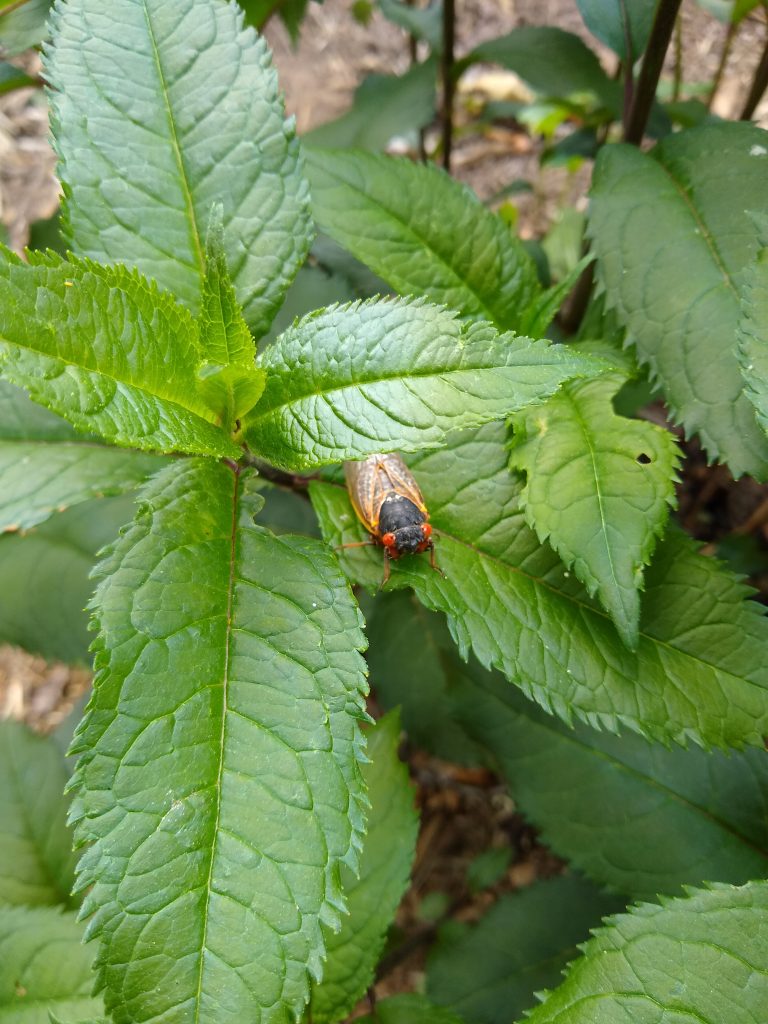Cicadas – Brood X
By Misty Kuceris, Horticulturalist, Burke Nursery & Garden Centre

May 16, 2021: Brood X is officially here in Northern Virginia. For weeks people have come into the Nursery with pictures of holes in the ground wondering what they were…Actually they were the initial signs that they had Brood X cicadas in their yard.
Yesterday, as I walked around my property, I found the little and big ones everywhere. I started by looking at the holes in my garden near my maple tree.

No amount of mulch could prevent those little nymphs from emerging from their sleep. They were too anxious to become adults and bring more little nymphs into the world 17 years later.
As a matter of fact, I could find the exoskeletons of the nymphs all over my Hot Lips Turtlehead (Chelone lyonia ‘Hot Lips’) perennial.


The good news is that the cicadas can care less about perennials, annuals, vegetables, and herbs. They actually don’t care that much for small shrubs, although sometimes they do.
But they do care about laying eggs in the tender branches of small ornamental trees, some shrubs, and fruit trees. They tend to land, and lay their eggs, on the branches that are about the size of a pen or pencil that up to two inches in diameter. For this reason, you really don’t need to worry about your mature trees. So, what can you do to protect your trees or shrubs?

You don’t want to use insecticides because they won’t reduce the cicada population or prevent the female cicadas from laying her eggs. Instead, if you’re concerned, you want to cover your tree or shrub with netting that has ¼-inch or smaller openings. According to the University of Maryland Extension office some insect netting with holes 3/8 inch large were also effective the last time this occurred. Just make sure that when you place the netting around your trees or shrubs you secure it to the ground or base of the tree so that birds and other wildlife don’t get trapped.
While you need to keep the netting on from the time the cicadas emerge for up to 6 to 8 weeks until there are gone there are a few things you need to know about your plants. If you see any injury to your shrub, you can usually just prune it away. Leaves on some trees and shrubs may actually get sunburn after you remove the netting because the sun is a little too much for them all at once. Flowers may not emerge because not only did you prevent the cicadas from coming, but you also preventer the pollinators from doing their job. Finally, your tree or shrub may not grow as much during this time period although the normal growth will resume; or it may get a fungal infection in the leaves which can be taken care of.
One other thing: If you have any ponds, please cover your ponds with screening or plastic mesh. If you get too many cicadas in your pond you could find the oxygen depleting and the fish having problems.
So, what’s the benefit to cicadas? I wish I could take a picture of all the birds doing what I’m calling the helicopter movement in my front yard. Songbirds love eating cicadas! In addition, when the nymphs emerge from the ground, not only do they aerate your lawn and gardens, but they also release nutrients from the soil which, according to the University of Illinois Urbana-Champaign (Illinois Extension), provides fertilizer to your plants.
Let me know if you have any questions. Misty Kuceris, Horticulturalist, Burke Nursery & Garden Centre.


![pumpkin[1]](/wp-content/uploads/2013/03/pumpkin1.png)
![197454109[1]](/wp-content/uploads/2013/03/1974541091.png)



How do I know which small shrubs to cover with nets before it is too late and the cicadas have already laid their eggs on it?
Thanks,
Bev
You’ll find either the cicada exoskeleton on the leaves right now or perhaps a one or a few cicadas on the shrub leaves. If the branches are smaller than 1/2, the female cicada isn’t interested in that branch for her nesting because it’s too small. Right now (as of May 20th) you can simply brush the cicadas off and, if you want, cover with a net. We now have cicada netting here at Burke Nursery & Garden Centre.